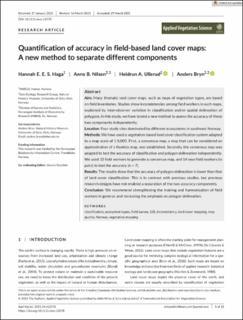| dc.contributor.author | Haga, Hannah Emma Emilie Strømsrud | |
| dc.contributor.author | Nilsen, Anne-Barbi | |
| dc.contributor.author | Ullerud, Heidrun Asgeirsdatter | |
| dc.contributor.author | Bryn, Anders | |
| dc.date.accessioned | 2021-11-03T11:31:19Z | |
| dc.date.available | 2021-11-03T11:31:19Z | |
| dc.date.created | 2021-05-12T20:43:43Z | |
| dc.date.issued | 2021-04-02 | |
| dc.identifier.citation | Applied Vegetation Science. 2021, 24 (2), 1-13. | en_US |
| dc.identifier.issn | 1402-2001 | |
| dc.identifier.uri | https://hdl.handle.net/11250/2827562 | |
| dc.description.abstract | Aim Many thematic land cover maps, such as maps of vegetation types, are based on field inventories. Studies show inconsistencies among field workers in such maps, explained by inter-observer variation in classification and/or spatial delineation of polygons. In this study, we have tested a new method to assess the accuracy of these two components independently. Location Four study sites dominated by different ecosystems in southeast Norway. Methods We have used a vegetation-based land cover classification system adapted to a map scale of 1:5,000. First, a consensus map, a map that can be considered an approximation of a flawless map, was established. Secondly, the consensus map was adapted to test the accuracy of classification and polygon delineation independently. We used 10 field workers to generate a consensus map, and 14 new field workers (in pairs) to test the accuracy (n = 7). Results The results show that the accuracy of polygon delineation is lower than that of land cover classification. This is in contrast with previous studies, but previous research designs have not enabled a separation of the two accuracy components. Conclusion We recommend strengthening the training and harmonization of field workers in general, and increasing the emphasis on polygon delineation. | en_US |
| dc.language.iso | eng | en_US |
| dc.publisher | John Wiley & Sons Ltd. | en_US |
| dc.rights | Navngivelse 4.0 Internasjonal | * |
| dc.rights.uri | http://creativecommons.org/licenses/by/4.0/deed.no | * |
| dc.title | Quantification of accuracy in field-based land cover maps: A new method to separate different components | en_US |
| dc.type | Peer reviewed | en_US |
| dc.type | Journal article | en_US |
| dc.description.version | publishedVersion | en_US |
| dc.rights.holder | © 2021 The Authors | en_US |
| dc.source.pagenumber | 1-13 | en_US |
| dc.source.volume | 24 | en_US |
| dc.source.journal | Applied Vegetation Science | en_US |
| dc.source.issue | 2 | en_US |
| dc.identifier.doi | 10.1111/avsc.12578 | |
| dc.identifier.cristin | 1909811 | |
| dc.source.articlenumber | e12578 | en_US |
| cristin.ispublished | true | |
| cristin.fulltext | original | |
| cristin.qualitycode | 1 | |

